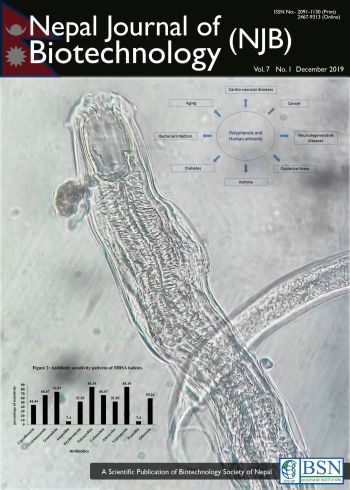Vancomycin Intermediate MRSA Isolates Obtained from Retail Chicken Meat and Eggs Collected at Pokhara, Nepal
DOI:
https://doi.org/10.3126/njb.v7i1.26958Keywords:
MRSA, vancomycin-intermediate, S. aureus, eggs, meatAbstract
Antimicrobial resistance among food animal isolates is increasing as a result of their uncontrolled uses. The monitoring of antibiotic resistance among these isolates is very necessary. S aureus was isolated from eggshells and chicken meat samples collected from different retail outlets of the Pokhara metropolitan. Samples were inoculated on Mannitol salt agar aseptically and inoculated overnight. Isolated yellow colonies were further examined by Gram-staining, catalase, and coagulase test to detect S aureus. Methicillin resistance was screened using cefoxitin disc. Vancomycin minimum inhibitory concentration (MIC) of Methicillin-resistant S aureus (MRSA) isolates were determined by the agar dilution method following CLSI guidelines. 139 S aureus were isolated from 205 samples. Among them, 89 were from egg samples (out of 125 samples) and 50 from chicken (out of 80 samples). The overall prevalence of MRSA was 12.94%. Antibiotic resistance was significantly higher in MRSA isolates compared to Methicillin sensitive S aureus (MSSA) isolates. The highest rate of resistance was noted for ampicillin, amoxicillin, and erythromycin while the least resistance was noted for gentamicin and amikacin. Vancomycin minimum inhibitory concentration (MIC) range of the MRSA isolates was 0.25-8μg/ml indicating the detection of both vancomycin-intermediate and sensitive isolates from the samples. This is the first study reporting vancomycin-intermediate S aureus (VISA) isolates from Nepal and indicates the increasing drug resistance among animal isolates. Further surveillance studies about the transmission of these pathogens to humans as well as detail molecular analyses are imminent.
Downloads
Downloads
Published
How to Cite
Issue
Section
License
Copyright Notice:
The manuscript submitted to NJB must be an original contribution, not previously published and should not be under consideration for publication elsewhere. When the manuscript is accepted for publication, the authors agree to automatically transfer the copyright of the article to the publisher. It should grant permission to any third party, in advance and in perpetuity, the right to use, reproduce or disseminate your article, according to the NJB copyright and license agreement.
Authors transfer copyright to the publisher as part of a journal publishing agreement but have the rights to: Share their article for Personal Use, Internal Institutional Use and Scholarly Sharing purposes, with the NJB applies the Creative Commons Attribution-NonCommercial CC BY-NC license to all the works we publish after Jun 2020 (Before it was CC BY-NC-ND). Under this license, authors agree to make articles legally available for reuse, without permission or fees, for virtually any non-commercial purpose. Anyone may remix, adapt, and build upon your work non-commercially, and although their new works must also acknowledge you and be non-commercial, they don’t have to license their derivative works on the same terms. More details on CC BY-NC refer to its Licence Deed and Legal Code.






